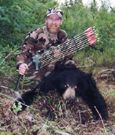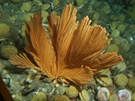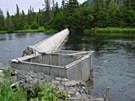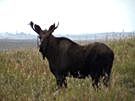Alaska Fish & Wildlife News
November 2004
Hunters Share Three Views of Bear Baiting

Almost two dozen black bears visited a bait station set up by Tom Payer in just three days, giving the long-time Alaska bowhunter ample opportunity for a clean shot at the bear of his choice.
Using bait to hunt black bears in Alaska has become a contentious issue, and this November voters statewide will weigh in on the debate. Some people believe that attracting black bears to bait stations is acceptable, sporting and fair, and allows hunters to be selective and humane. Others believe ...
Bear Baiting ArticleContinued
Alaska’s Salmon-Eating Wolves

The wolf puppy was fishing in the intertidal zone, working the riffles where salmon were exposed in the shallow stream. She waded into the water to grab a fish and pulled it flopping onto the bank, where she ate just the head.
It's a scene Dave Person has witnessed many times. The Alaska Fish and Game biologist has been studying wolves on Prince of Wales Island for 12 years, documenting habitat needs, denning requirements and a variety of behaviors. He's monitored this fishing behavior ...
Wolves ArticleContinued
Coral Gardens Discovered in the Aleutian Islands

Most people associate brilliant coral displays with snorkeling in the tropics, not with the cold waters of the Aleutian Islands of Alaska.
In July of 2002, large tracts of colorful coral gardens were discovered in the Aleutian Islands of southwestern Alaska. Scientists estimated that as many as 100 species of coral were flourishing 300 to 5,000 feet beneath the surface.
Unlike their tropical counterparts, the Aleutian corals do not need light to survive, but instead rely on nutrients ...
Coral Gardens ArticleContinued
Working at a Fish Weir

Fish weirs have been used to capture fish since prehistoric times. A weir, essentially a fence placed in flowing waters, directs the movement of fish.
Traditionally this was done to catch fish, but in modern-day Alaska, weirs are essential tools for the management and research of many fish stocks, especially salmon and trout.
Weirs help Fish and Game workers count fish moving up or downstream. Of all the streamside assessment tools, including counting towers and sonar, a weir ...
Fish Weir ArticleContinued
Ancient Indications of Angling and Ethics

Humans have been fishing for sport as well as food for almost as long as fishing has existed. In Europe, angling for pleasure can be traced back to the first century A.D. In the Far East, sport fishing - with bamboo rods, silk lines, flies, and barbless hooks - dates back more than 3,000 years.
Parallel to this long history of sport angling are signs of the development of angling ethics. There were very early discussions about the need to limit one's catch. Releasing fish alive may be ...
Angling History ArticleContinued
That’s No Bull – It’s a Cow!

Don't shoot! It may look like a legal young bull – but it's not. That's a cow moose sporting a deformed set of antlers – and she has a young calf with her.
The pair was recently sighted near Nome in the vicinity of Dredge #5, near Icy View, by Vickie Tanner, who captured the antlered cow on video. Her husband Noel Tanner noticed, “That bull has udders!”
They watched the animal behaving in a typically maternal manner toward the calf.
Kate Persons, Alaska Department of ...
Bull or Cow ArticleContinued
Alaska Wildlife Curriculum Now Available Online

The Alaska Wildlife Curriculum, developed by the Alaska Department of Fish and Game and the U.S. Fish and Wildlife Service, is designed for teachers who wish to open their classroom doors and windows to the natural world. The curriculum teaches students in kindergarten through grade 12 ecological principles that lead to conservation of Alaska's wildlife and wild lands.
In the past, most Alaska teachers have attended a weekend-long training workshop to help them integrate the wildlife curriculum ...
Wildlife Curriculum ArticleContinued
Licensing Guides Benefits Anglers and Alaska

Alaska is a world class destination for sport fishing. Non-residents and a number of Alaska residents access Alaska's abundant fisheries by hiring sport fishing guides. In Alaska, the sport fishing guide industry contributes over $600 million a year to our state's economy. Yet, up until this year, this important industry has not been licensed by the State of Alaska.
Currently, anyone can become a sport fish guide in the State of Alaska. Although many guides already have insurance, ...
Fishing Guides ArticleContinued
